Don't wanna be here? Send us removal request.
Text
Internet/Social Media: Linh Truong
Linh Truing is currently a senior at Georgetown University in Washington DC and also a content creator on Instagram, TikTok, and Youtube. Their focus is on fashion, commentary, lifestyle, and travel content. Linh is Asian-American (half Vietnamese, half Chinese) and leans into her Vietnamese heritage in her content and life. They have been creating videos for YouTube since 2018. They have over 1.6 million followers/subscribers across different platforms.

I personally found Linh because of her room tours/organizational videos. Linh is also queer, identifying as non-binary, and uses she/they pronouns. Since 2018, Linh has been focused on graduating high school and going to college. Her goal (at least at this stage in life) is not to become a full-time influencer/YouTuber/content creator after college, but to get a job. She is going to school for sociology.
youtube
Linh is very proactive on social media. Since starting college (around 2020ish), they have been including resource links in the description of every video for things such as supporting trans and queer people, supporting black people, AANHPI (Asian American, Native Hawaiian, and Pacific Islander), and others. Not only this, but they are also very active on Instagram with more real time events. She is a big advocate for those underrepresented and makes the effort to give them the platform they deserve. Linh also uses her platform/the public eye to get people they help or eyes they may need. She is very outspoken about her views on political and cultural matters.

Something that Linh has really been playing with recently has been fashion. They make a lot of content having to do with fashion and clothing that plays with twisting gender norms, combining uncommon things together, and being authentically themselves. I feel like this is a great relation to class because Linh uses fashion in a way that could be considered art. She combines different cultural clothing to make it into something different.
Linh also makes art, jewelry is one that is the most recent (she has also made art prints, stickers, and others). Her jewelry too is heavily influenced by her cultural upbringing, she even comments that it was “inspired by the jewelry I saw my mom wear growing up.” The initial gold jewelry line with En Route was released in late 2022, but silver versions of the pieces were later released around a year later.
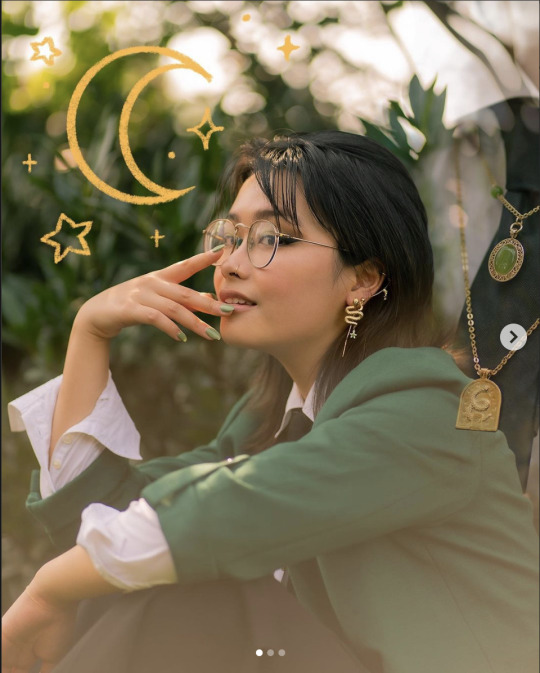
Snakes have significance in Chinese mythology such as the duality of nature in Chinese philosophy, wisdom and knowledge, protection, etc. This directly relates to Linh’s heritage! (Referenced https://ishocalligraphy.com/blog/chinese-snake-symbolism-a-fascinating-journey-into-chinese-culture/)
While there isn’t a direct relation to the readings we’ve had this semester (especially because we only really read the Chinese perspective of emigration to the United States), their ties towards both heritage/cultural identity in relation to the world we know today is one that isn’t as public as what Linh is doing.
youtube
6 notes
·
View notes
Text
Movie: Coco (2017)
I can’t believe I’ve never seen this film before. I really enjoyed it. I chose to watch the Disney film Coco which was released in 2017. It was directed by Leo Unkrich, who also directed Toy Story 3 (2010). It follows 12-year-old Miguel Rivera who lives with his shoe maker family. He longs to be a musician, but his family forbids music for generations because of the disappearance of their great great grandpa (who was a guitarist). When Miguel gets stuck in the land of the dead, he has to get a blessing from his great great grandmother to return to the normal world. The biggest theme in this film is the importance of family.
Part of the opening scene (https://youtu.be/pNGEifXom4M?si=MqUIQafiL9ozWkWn)
Short recap of the plot of the film (https://youtu.be/4Lkppf3q-a8?si=ppTUExb9u-OVWezM)
The film centers on El Die de los Muertos (The Day of the Dead) while Miguel tries to both play music and connect with his (and many others) favorite musician Ernesto de la Cruz. Eventually, Miguel will come to meet de la Cruz, as well as his great great grandmother Imelda and other deceased family members.


Visually, the film is VERY colorful. As mentioned before, it is also set during Dia de los Muertos, which is a holiday traditionally celebrated from November 1 and 2 and widely observed in Mexico (where the film takes place). Traditions include honoring the deceased by building home altars (ofrendas) that include photos and food/drink for the departed.

There are also often marigold flowers (cempazuchitl) that show the spirit the way.

From an outsider perspective, this celebration is a big deal, especially since the film centers around it. Traditions like these were never really mentioned in our readings, but may be because this film takes place physically in Mexico instead of, say, a Mexican family living in the United States. One thing I did notice, however, was that Catholicism was highlighted a tiny bit in this film. It definitely wasn’t at the forefront, it was hinted at — there were crosses on the walls of the home and characters would do the sign of the cross. This too was hinted at in the “El Norte” reading (Takaki chapter 12). Children of Punjabi/Mexican families would be baptized Catholic.

The biggest part of this film is the family aspect — it’s what drives the film. Miguel is ready to separate himself from his family to do what he longs to do (play music) while, around him, his family insists he is ready to start making shoes. In the end, family is still the end-all-be-all, but they understand each other better than before.
Music, too, is a big thing that I know is also a huge Mexican tradition. I wanted to include Miguel’s performance here. (https://youtu.be/yg8116aeD7E?si=Qa24K6FOL6rDWGwG). They are not afraid to include Spanish in this film either, which makes it feel more authentic.
Overall, a great film and an important one when thinking of family and ancestors.
0 notes
Text
TV: Reservation Dogs (Blog 1)
The television show I decided to watch was Reservation Dogs (2021-23). This series follows teenagers Elora, Bear, Chester (Cheese), and Willie Jack called the Rez Dogs. They live in rural Oklahoma where they commit crime and fight it. Season one takes place one year after the death of their friend Daniel, who dreamed of going to California. In this coming of age show, the Rez Dogs grapple with Daniel’s death, contemplate going to California themselves, and grow into themselves along the way. The show was created by Sterlin Hart and Taika Waititi, has three seasons, features all Indigenous writers and directors, and also has an almost entirely Indigenous cast and crew.
The first thing that really stuck out to me about this show was the attention to detail in both the costuming and set design. There were aspects that certainly called upon Native American culture, in particular braids. I wanted to go back to the reading “Prairie Portraits” by Aleta M. Ringlero where this idea of clothing was a main focus. Ringlero especially talked about photography and how it influenced the way we think about Native Americans today. In Reservation Dogs the only time we see “traditional” clothing is on the character William Knifeman who appears to Bear as a spirit. (https://youtu.be/b_-x60mIAvg?si=DeX7In6e0YEuZHUC)
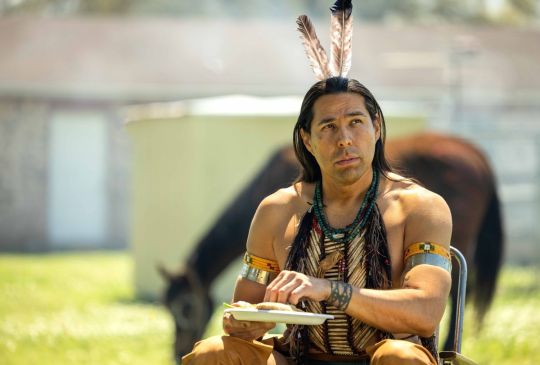
Otherwise, a reoccurring theme is braids. I know that braids/hair in general is significant to Native American culture and I found it uplifting that the design team paid careful attention to it.
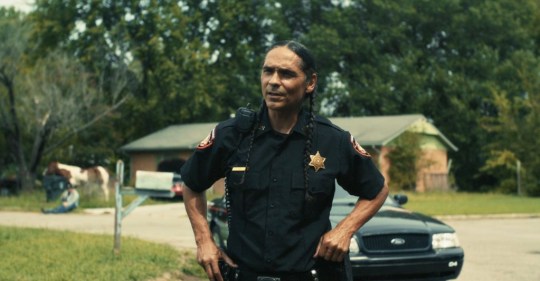
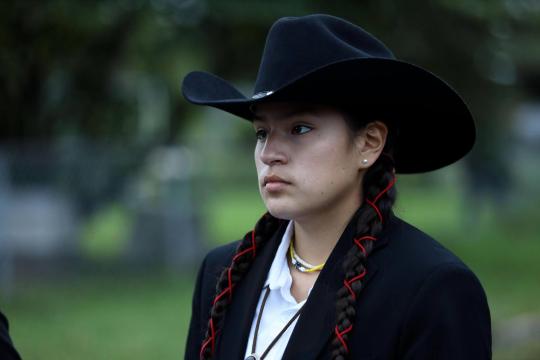
While the main focus is on the Indigenous story, there are also constant references/conversation around what it means to be Native, and white people in the area treating it differently. For example, the character Big is a Tribal Policeman (Lighthorseman) who, at one point, comes into contact with the Okern (the town) police who start to poke fun (basically bullying him) at Big. Another great example, on the opposite side of the spectrum, would be the character Kenny Boy, a white man who keeps trying to convince people he is Native American by throwing in mispronounced (and misused) words and concepts into daily speech.
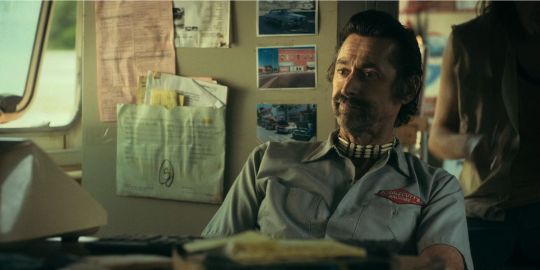
Another thing that was explored/commented on through this series was the idea of Christianity. There is a church in the town which they gather in the basement during tornado in the last episode of season one. They don’t care — they have no connection with it at all, it is just a place for them to be safe from the storm. They reference images or statues of Jesus as “White Jesus.” This goes back to the “Circling the Cross” reading by Antonio Lopez. How Native Americans see symbols as “cyphers of power.” In contrast to White Jesus, characters wear copper jewelry and eagle feathers pop up every once in a while.
The last thing I want to mention is the quick reference to the idea of land. In the episode titled “Uncle Brownie” (S1E3), the “Welcome to Oklahoma” sign has “Land Back” in spray paint on covering it. There are a few other signs throughout the rest of the season that had this tag as well.
Overall, this series features Indigenous people as authentically as I can imagine in a present day sense. Highly enjoyed it and highly recommend it!
0 notes